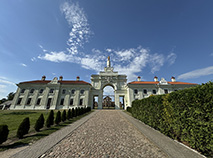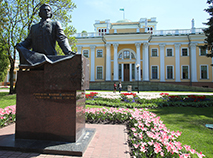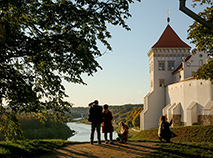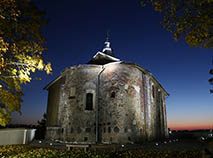Architecture of Belarus
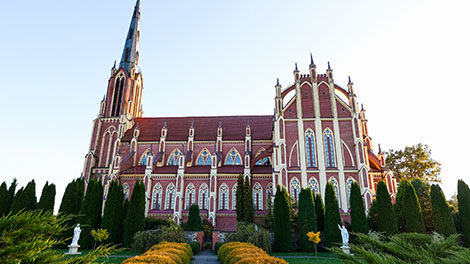
Influences of both eastern and western cultures are reflected in the diverse architectural styles of Belarus churches, castles, palaces and fortresses.
Belarusian architecture through the ages
Despite its turbulent history of war and destruction, many architectural treasures and attractions of Belarus have survived to tell the history of this fascinating country.
Some of the oldest buildings of Belarus date from the Middle Ages.
Artistic movements and religions have played their part in shaping the architecture of Belarus, with fine examples of Romanesque and Gothic, Baroque and Classicism, Modernism and Eclecticism to be found across the country.
Architecture in the Brest region
Brest fortress is the main architectural tourist attraction in the city of Brest. It dates back to 1830s. Other noteworthy buildings include:
-
St Simeon’s Orthodox Cathedral, an example of architecture of pseudo-Russian style (1865)
-
Roman Catholic Church of Exaltation of the Holy Cross (Vozdvizhenie Sviatogo Kresta) (1856)
-
Railway station, an example of architecture of the Pseudo-Russian style (1886).
Architectural monuments in the Brest area include:
-
Kamenets tower (Belaya Vezha), a fine example of defensive architecture (13th Century)
-
Charles Baramesha's Church in Pinsk, an example of baroque architecture (18th Century)
-
Butrimovich Palace in Pinsk, an example of late baroque architecture (1784-1790)
-
The Palace complex in Ruzhany (17th – 18th Century)
-
Kossovo Palace, which shows elements of classicism (19th Century).
Architecture in the Gomel region
The main attraction of Gomel is the palace-park ensemble centred around the classical-style palace of Rumyantsev-Paskevich (1799-1819).
Architectural attractions of the Gomel area include:
-
Mozyr church and Bernadine Cloister, an example of baroque architecture (1648)
-
Cistercian Cloister (1743-1745)
-
Petrikovsky Nikolaev church, an example of the Pseudo-Byzantian style architecture (2nd half of 19th Century)
-
Chechersk town hall, classical style (2nd half of 18th Century).
Architecture in the Grodno region
The Grodno region offers the visitor a wealth of ancient and beautiful buildings to discover and enjoy.
The unique architectural monuments of Grodno include:
-
Borisoglebsky (Kalozhskaya) church, an example of Old Russian architecture (2nd half of 12th Century)
-
Royal Palace, an example of rococo architecture (1734-1751)
-
Church of St. Franziska Ksaverij, an example of baroque architecture (late 17th – 18th Century).
-
Franciscan monastery, an example of baroque architecture (18th Century).
In the Grodno the most prominent remaining ancient castles are:
-
Mir Castle, a UNESCO world heritage site – one of the famous castles in Belarus and an outstanding example of defensive architecture (16th Century)
-
Lida Castle (14th – 15th Century).
Historical religious monuments include:
-
Piously-Mikhailovsky church in the village Synkovichi (Zelva area), an example of defensive architecture with gothic features (late 15th to early 16th Century).
-
Church-fortress in the village of Murovanka (Schuchin area), an example of defensive architecture (early 16th Century)
-
St. Uspensky Zhirovichi Monastery (17th – 18th Century)
Architecture in the Minsk region
Although many important buildings and monuments in the Minsk region were destroyed by war, those that have survived include:
-
Petropavlovskaya Orthodox Church, an example of architecture with elements of renaissance and baroque (1611)
-
Deva Maria Catholic Church (1798)
-
Alexander Nevsky Church, an example of the retrospektiva-Russian style (1898)
-
Kalvarijsky church, an example of neo-gothic style (19th Century).
-
The Church of St. Simon and Elena (Red church), a neo-gothic building with modernist features (1908-1910).
The main attractions in the Minsk region are architectural monuments found in the town of Nesvizh:
-
Nesvizh palace - park complex (16th – 19th Century).
-
Nesvizh church of the Divine Body, an example of baroque architecture (1584-1593).
-
Slutsk Brahma, an example of baroque architecture (17th – 18th Century)
Other architectural monuments of the Minsk region:
-
Bernardin Church in Budslav (Myadel area), an example of baroque architecture (18th Century)
-
Voskresensky Cathedral in Borisov, an example of the Pseudo-Russian style (1874)
-
Spaso-Preobrazhenskaya Church in Zaslavl (late 16th to early 17th Century)
Architecture in the Mogilev region
Surviving architectural monuments of the ancient city Mogilev:
-
Nikolaevskaya Tserkov, an example of baroque architecture (1669-1672)
-
Stanislavskiy Kostiol, an example of baroque architecture (1738-1752)
-
Archiepiscopal palace, an example of architecture of classicism (about 1780)
-
Mogilev town hall (17th – 20th Century).
Mogilev region:
-
Shklov town hall, an example of classical architecture (late 18th Century)
-
Preobrazhensky church in Shklov, an example of the neo-Russian architecture (early 20th Century).
-
Sviato-Troitskaya Tserkov in Bykhov, wooden style (mid-19th Century)
-
Synagogue in Bykhov, an example of architecture of the late Renaissance (mid-17th Century)
-
Bobruisk Fortress, an example of defensive architecture (1st half 19th Century).
-
Bykhov Castle, an example of palace-castle architecture (late 16th to early 17th Century).
-
Palace in Zhilichi (Kirov area), an example of classical style (1830s)
Architecture in the Vitebsk region
Orthodox and Catholic churches of the Vitebsk area represent various styles of temple architecture. Surviving buildings in Vitebsk include:
-
Blagoveshchenskaya church, an example of Old Russian architecture (mid-12th Century)
-
Kazan church, a specimen with elements of baroque and early classical architecture (1760)
-
Varvariansky church, in the neo-Romantic style (1785)
Ancient architectural sights in the town of Polotsk include:
-
St. Sofia Cathedral, (11th - 18th Century), one of three Old Russian temples devoted to St. Sofia. (The others are in Kiev and Novgorod.)
-
Spaso-Evfrosinievsky church, an example of Old Russian architecture (1152-1161). Unique ancient frescos are still visible on its walls and columns.
Original examples of temple architecture in the Vitebsk region include:
-
St. John Krestitelja Church in Kamai (Postavy area), a monument combining forms of defensive, Gothic and Renaissance architecture (1603-1606)
-
Church in Sariya (Verkhnedvinsk area), an example of neo-gothic architecture (1852-1857).



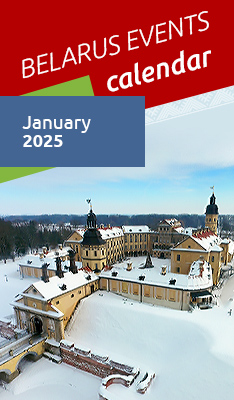




 print version
print version make home page
make home page add to bookmarks
add to bookmarks
